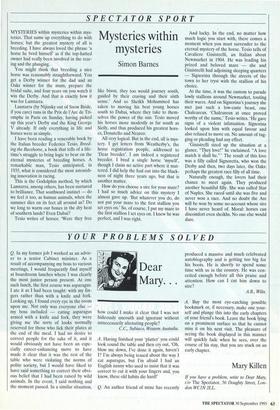SPECTATOR SPORT
Mysteries within mysteries
Simon Barnes
MYSTERIES within mysteries within mys- teries. That sums up everything to do with horses; but the greatest mystery of all is breeding. I have always loved the phrase 'a horse he had himself' as if the top-hatted owner had really been involved in the rear- ing and the plunging.
You might think that breeding a nice horse was reasonably straightforward. You get a Derby winner for the dad and an Oaks winner for the mum, prepare the bridal suite, and four years on you watch it win the Derby. And that is exactly how it was for Lamtarra.
Lamtarra (by Nijinsky out of Snow Bride, if you care) runs in the Prix de l'Arc de Tri- omphe in Paris on Sunday, having picked up this year's Derby and the King George V already. If only everything in life and horses were as simple.
I have been reading a venerable book by the Italian breeder Federico Tesio, Breed- ing the Racehorse, a book that tells of a life- time's struggle to bring logic to bear on the eternal mysteries of breeding horses. A remarkable man, Tesio anticipated, in 1935, what is considered the most astonish- ing innovation in racing. This is the Godolphin method, by which Lamtarra, among others, has been nurtured to brilliance. That southward instinct — do we feel it too, as human animals, when the summer dies on its feet all around us? Do we long to warm our bones in the dry heat of southern lands? Even Dubai?
Tesio writes of horses: 'Were they free like bison, they too would journey south, guided by their craving and their sixth sense.' And so Sheikh Mohammed has taken to moving his best young horses south to Dubai, where they take to them- selves the power of the sun. Tesio moved his horses more modestly as far south as Sicily, and thus produced his greatest hors- es, Donatello and Nearco.
All very logical. But in the end, all is mys- tery. I get letters from Weatherby's, the horse registration people, addressed to `Dear breeder'. I am indeed a registered breeder. I bred a single horse 'myself, though I claim no active part where it mat- tered. I did help the foal out into the black- ness of night three years ago, but that is another matter.
How do you choose a sire for your mare? I had so much advice on this mystery I almost gave up. 'But whatever you do, do not put your mare to the first stallion you set eyes on.' So, of course, I put my mare to the first stallion I set eyes on. I knew he was perfect, and I was right. And lucky. In the end, no matter how much logic you start with, there comes a moment when you must surrender to the eternal mystery of the horse. Tesio tells of Cavaliere Ginistrelli, an Italian about Newmarket in 1904. He was leading his prized and beloved mare — she and Ginistrelli had adjoining sleeping quarters Signorina through the streets of the town to her tryst with the stallion of his choice.
At the time, it was the custom to parade lowly stallions around Newmarket, touting their wares. And on Signorina's journey she met just such a low-caste beast, one Chaleureux. `Chaleureux at once proved worthy of the name,' Tesio writes. 'He gave signs of a violent infatuation. Signorina looked upon him with equal favour and also refused to move on. No amount of tug- ging or pleading had any effect.
`Ginistrelli sized up the situation at a glance. "They love!" he exclaimed. "A love match it shall be."' The result of this love was a filly called Signoretta, who won the Derby and then, two days later, the Oaks: perhaps the greatest race filly of all time.
Naturally enough, the lovers had their chance to meet again. They produced another beautiful filly. She was called Star of Naples. She raced until she was five and never won a race. And no doubt the Arc will be won by some no-account whose sire I have never heard of. Moral: horses can discomfort even sheikhs. No one else would dare.


































































 Previous page
Previous page